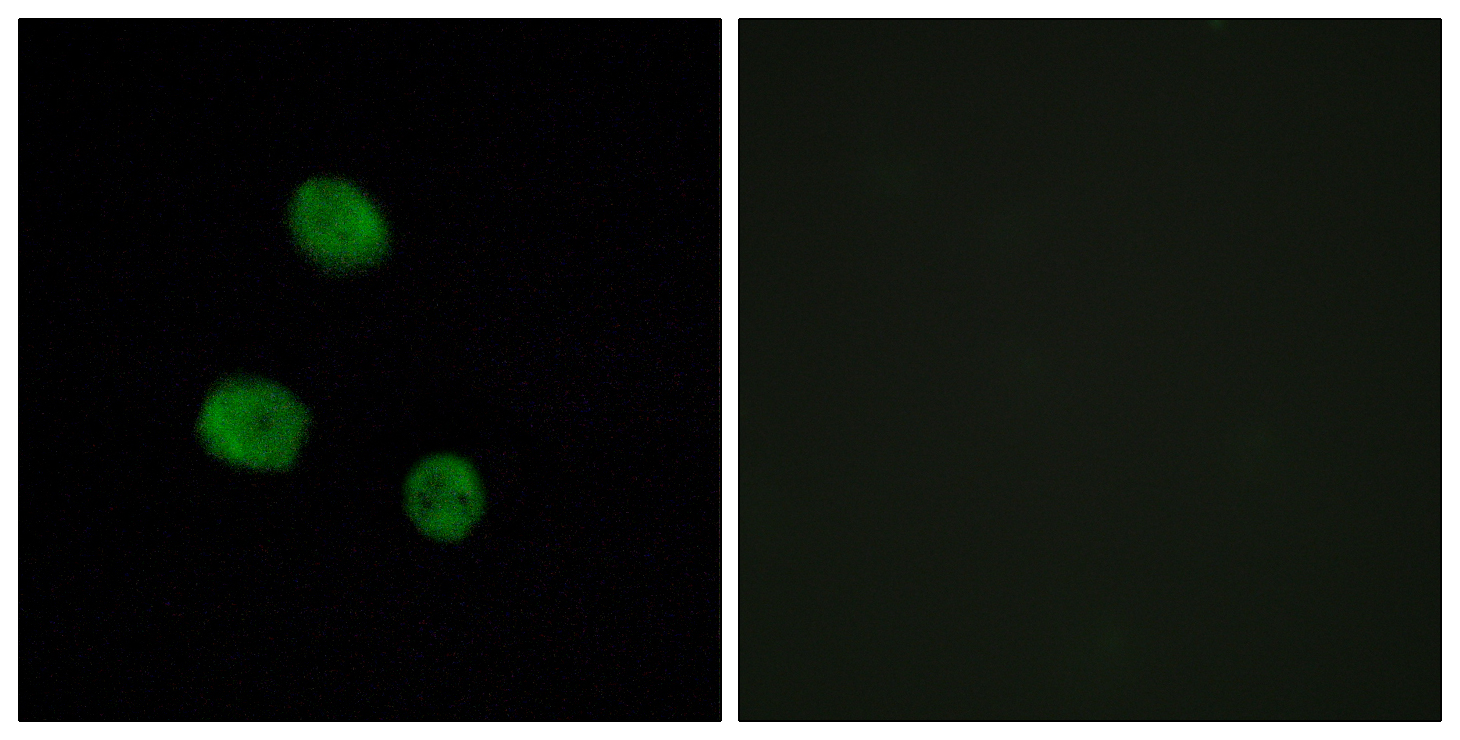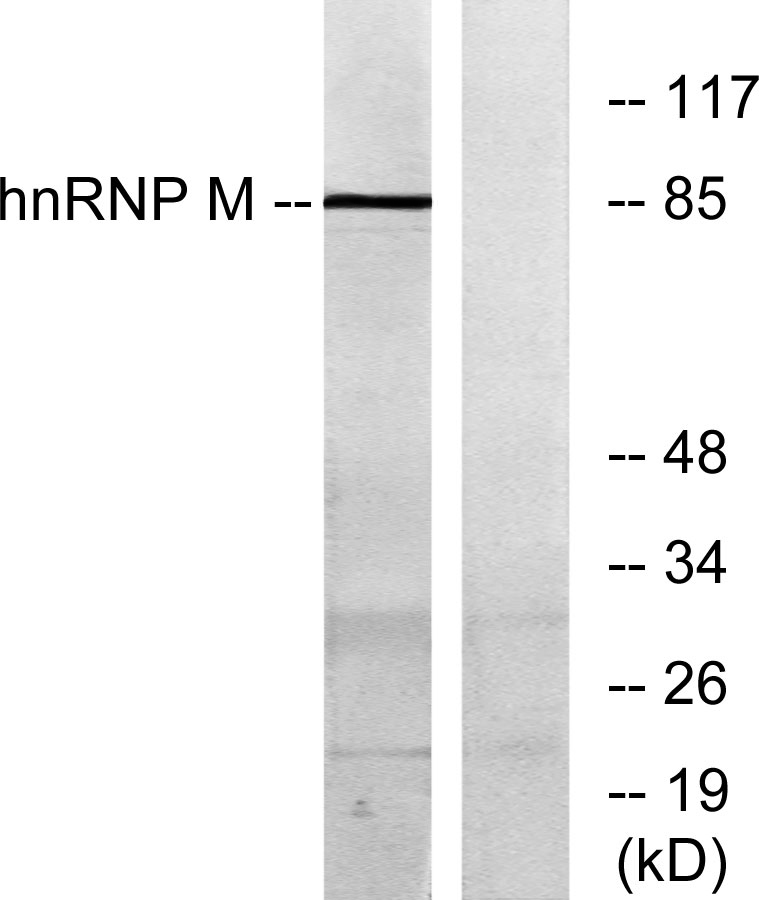hnRNP M Polyclonal Antibody
- Catalog No.:YT2205
- Applications:WB;IHC;IF;ELISA
- Reactivity:Human;Mouse;Rat
- Target:
- hnRNP M
- Fields:
- >>Spliceosome
- Gene Name:
- HNRNPM
- Protein Name:
- Heterogeneous nuclear ribonucleoprotein M
- Human Gene Id:
- 4670
- Human Swiss Prot No:
- P52272
- Mouse Gene Id:
- 76936
- Mouse Swiss Prot No:
- Q9D0E1
- Rat Gene Id:
- 116655
- Rat Swiss Prot No:
- Q62826
- Immunogen:
- The antiserum was produced against synthesized peptide derived from human hnRNP M. AA range:11-60
- Specificity:
- hnRNP M Polyclonal Antibody detects endogenous levels of hnRNP M protein.
- Formulation:
- Liquid in PBS containing 50% glycerol, 0.5% BSA and 0.02% sodium azide.
- Source:
- Polyclonal, Rabbit,IgG
- Dilution:
- WB 1:500 - 1:2000. IHC 1:100 - 1:300. IF 1:200 - 1:1000. ELISA: 1:40000. Not yet tested in other applications.
- Purification:
- The antibody was affinity-purified from rabbit antiserum by affinity-chromatography using epitope-specific immunogen.
- Concentration:
- 1 mg/ml
- Storage Stability:
- -15°C to -25°C/1 year(Do not lower than -25°C)
- Other Name:
- HNRNPM;HNRPM;NAGR1;Heterogeneous nuclear ribonucleoprotein M;hnRNP M
- Observed Band(KD):
- 78kD
- Background:
- This gene belongs to the subfamily of ubiquitously expressed heterogeneous nuclear ribonucleoproteins (hnRNPs). The hnRNPs are RNA binding proteins and they complex with heterogeneous nuclear RNA (hnRNA). These proteins are associated with pre-mRNAs in the nucleus and appear to influence pre-mRNA processing and other aspects of mRNA metabolism and transport. While all of the hnRNPs are present in the nucleus, some seem to shuttle between the nucleus and the cytoplasm. The hnRNP proteins have distinct nucleic acid binding properties. The protein encoded by this gene has three repeats of quasi-RRM domains that bind to RNAs. This protein also constitutes a monomer of the N-acetylglucosamine-specific receptor which is postulated to trigger selective recycling of immature GlcNAc-bearing thyroglobulin molecules. Alternative splicing results in multiple transcript variants. [provide
- Function:
- alternative products:Experimental confirmation may be lacking for some isoforms,function:Pre-mRNA binding protein in vivo, binds avidly to poly(G) and poly(U) RNA homopolymers in vitro. Involved in splicing. Acts as a receptor for carcinoembryonic antigen in Kupffer cells, may initiate a series of signaling events leading to tyrosine phosphorylation of proteins and induction of IL-1 alpha, IL-6, IL-10 and tumor necrosis factor alpha cytokines.,PTM:Sumoylated.,similarity:Contains 3 RRM (RNA recognition motif) domains.,subunit:Identified in the spliceosome C complex, at least composed of AQR, ASCC3L1, C19orf29, CDC40, CDC5L, CRNKL1, DDX23, DDX41, DDX48, DDX5, DGCR14, DHX35, DHX38, DHX8, EFTUD2, FRG1, GPATC1, HNRPA1, HNRPA2B1, HNRPA3, HNRPC, HNRPF, HNRPH1, HNRPK, HNRNPM, HNRPR, HNRPU, KIAA1160, KIAA1604, LSM2, LSM3, MAGOH, MORG1, PABPC1, PLRG1, PNN, PPIE, PPIL1, PPIL3, PPWD1, PRPF19, PRPF4B
- Subcellular Location:
- Nucleus, nucleolus .
- Expression:
- Brain,Cervix carcinoma,Duodenum,Epithelium,Lymph,Placenta,T
- June 19-2018
- WESTERN IMMUNOBLOTTING PROTOCOL
- June 19-2018
- IMMUNOHISTOCHEMISTRY-PARAFFIN PROTOCOL
- June 19-2018
- IMMUNOFLUORESCENCE PROTOCOL
- September 08-2020
- FLOW-CYTOMEYRT-PROTOCOL
- May 20-2022
- Cell-Based ELISA│解您多样本WB检测之困扰
- July 13-2018
- CELL-BASED-ELISA-PROTOCOL-FOR-ACETYL-PROTEIN
- July 13-2018
- CELL-BASED-ELISA-PROTOCOL-FOR-PHOSPHO-PROTEIN
- July 13-2018
- Antibody-FAQs
- Products Images

- Immunofluorescence analysis of MCF7 cells, using hnRNP M Antibody. The picture on the right is blocked with the synthesized peptide.

- Immunohistochemistry analysis of paraffin-embedded human breast carcinoma tissue, using hnRNP M Antibody. The picture on the right is blocked with the synthesized peptide.

- Western blot analysis of lysates from HT-29 cells, using hnRNP M Antibody. The lane on the right is blocked with the synthesized peptide.



